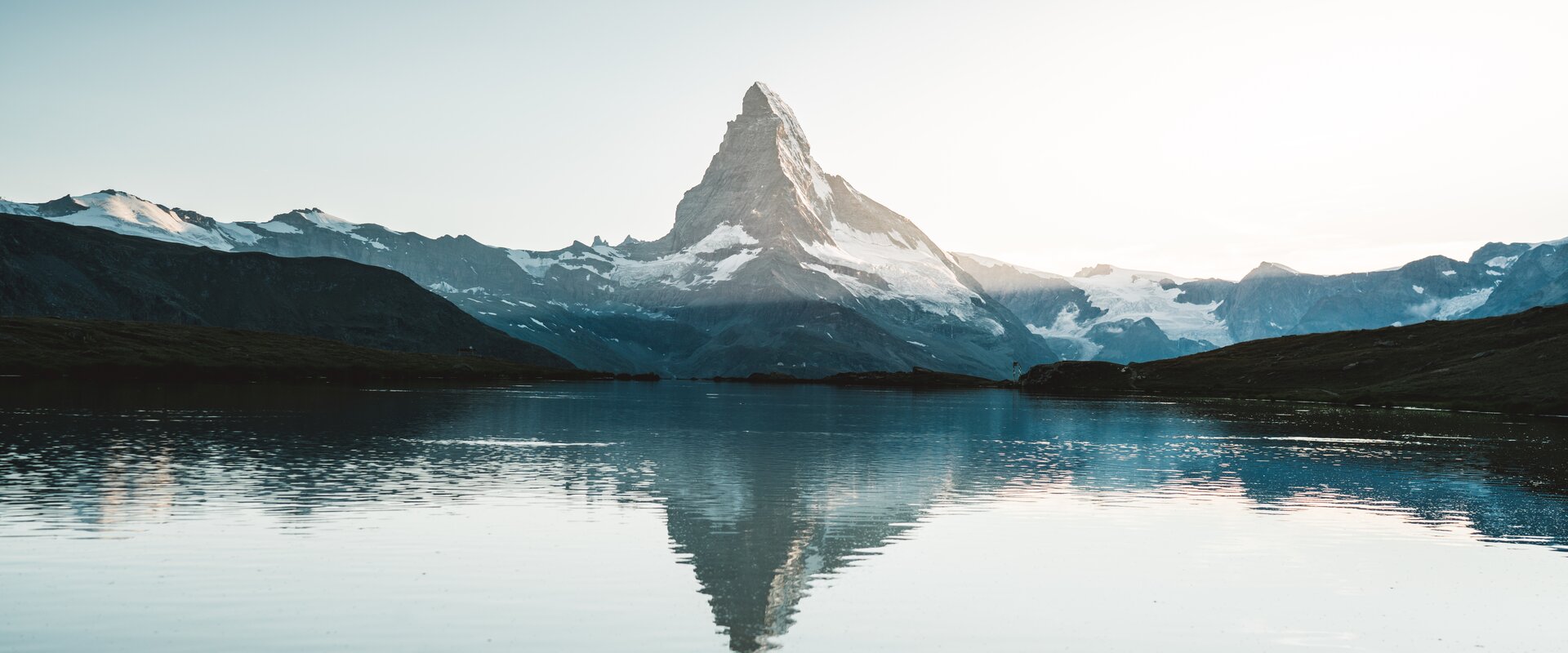Rising to 4478 metres, striking and unmistakable, perfectly formed like an Egyptian pyramid, it stands there at the end of the Matter valley in the midst of the Valais Alps: the Matterhorn. And yet – hard to believe but true – millions of years ago it was part of the African continent. Today, after extensive continental drift, it is one of the most distinctive mountains in the world and the best-known symbol of Switzerland.
The legend of the Matterhorn was born in 1865 when the peak was conquered for the first time and news of the event quickly travelled around the world. Over 150 years on, the peak, more than 4000 metres in altitude and once considered to be unconquerable, seems to act like a magnet on mountaineers from all over the world. Respect, awe, fascination – all of these make the legendary peak one of the most extraordinary destinations for travellers from near and far.
Matte + Horn = Matterhorn. The name derives, or so it is thought, from “Matte”, a dialect word meaning meadow, here referring to the grassy valley stretching out beneath the Gorner Gorge. It is that part of the valley where the village of Zermatt (“zur Matt”, or “on the meadow”) is located today. And “Horn”, which is the popular name for the Matterhorn among the local population. By contrast, locals on the Italian side of the nearby border refer to it as “Monte Cervino”.



Edward Whymper and the first ascent
It was considered unconquerable. There were tales of evil spirits and mountain demons. Nevertheless, some brave souls tried to climb it. All were doomed to fail. On 14 July 1865, the spell was broken. British mountaineer Edward Whymper conquered the Matterhorn. The first ascent was accomplished. But as so often, success and misfortune went hand in hand: during the descent from the peak, a rope parted and four members of Whymper’s seven-man rope party fell to their deaths.
Subsequently, the story of the mishap spread rapidly around the world, and the legend and fame of the village of Zermatt were born. It was from there that the seven young men had started out on their quest, among them Peter Taugwalder and his son of the same name, who were from Zermatt.
For Whymper, it was already the sixth attempt to climb the peak. Prior to the successful ascent, almost all the attempts had started from the Italian side via Valtournenche and the Lion ridge. No one thought it possible to climb the peak from any other side. No one except the ambitious Englishman, who set his sights on the north-east ridge. He intended to start out on his perilous adventure from Zermatt, rather than Breuil. And that is just what he did.

TRIUMPH AND TRAGEDY
No doubt Edward Whymper was motivated to some extent by anger. Why? He had previously tried to persuade his colleague Jean-Antoine Carrel to attempt the climb from the Swiss side. But then, by chance, he learned in July 1865 that Carrel, without telling him, was already on the way to the Lion ridge. “Now or never!”, Whymper must have said to himself, before hurrying to Zermatt to choose his climbing companions and set out for the Hörnli ridge.
And he actually won “the race”, reaching the summit well ahead of Carrel and his party. With Whymper were the French mountaineer Michel Croz, the Englishmen Reverend Charles Hudson, Lord Francis Douglas, D. Robert Hadow and two mountain guides a father and son both named Peter Taugwalder from Zermatt.
During the descent, the leading four in the rope party – Croz, Hadow, Hudson and Douglas – fell to their deaths. Days later three bodies were found on the Matterhorn glacier. The body of Lord Francis Douglas has not been discovered to this day.
The Matterhorn today
The legend of the Matterhorn remains intact to the present day. In favourable weather conditions, almost 300 climbers strike out daily from the base camp at Hörnlihütte, built in 1880, to climb the Hörnli ridge. That makes up to 3500 climbers every summer.

On the track of the legend in zermatt
In Zermatt, there are many memorials to remember the first ascent and the tragic accident:
- Matterhorn Museum: the (torn) original rope from the first ascent is one of many exhibits
- commemorative stone for Peter Taugwalder senior, Peter Taugwalder junior and Michel-Auguste Croz in the mountaineers’ cemetery.
- Hotel Monte Rosa: commemorative plaque and guided tours
- documentary film “Whymper’s Route up the Matterhorn” in the Vernissage Cinema.
- guided tours of the village.
Around the Matterhorn: other experiences Zermatt has in store ...
So, has that given you a yearn to visit the Matterhorn? Then away you go to Zermatt! The team at Zermatt Bergbahnen AG will be happy to advise you personally about your holiday plans.





